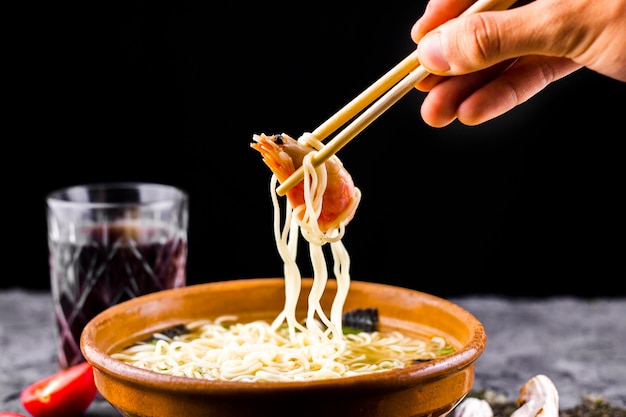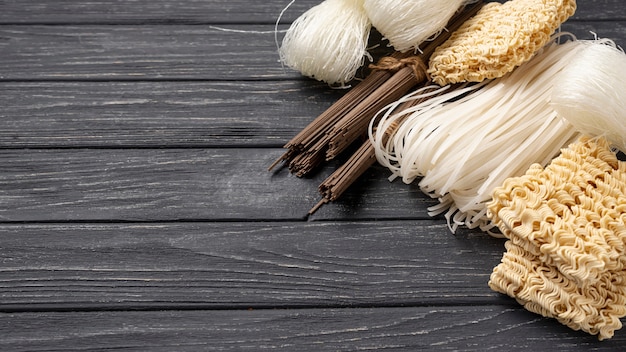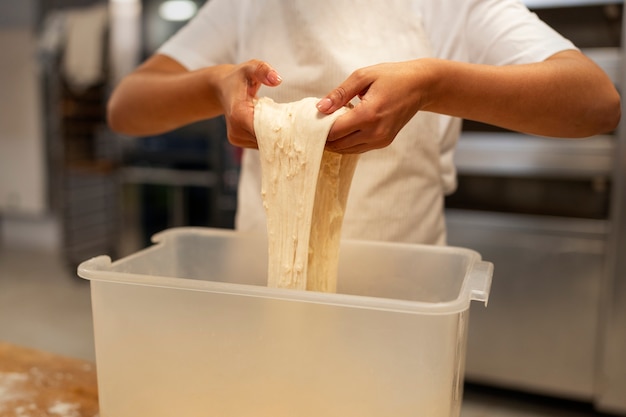Let's talk udon noodles! These thick, chewy beauties are a staple in Japanese cuisine, and they're a revelation. I first encountered udon in a little ramen shop in Tokyo, and I was instantly hooked. The springy texture, the hearty flavour, the sheer versatility – it's a culinary adventure waiting to happen. And the best part? It's super easy to cook udon at home, and I'm going to show you exactly how.
(Part 1) The Udon Odyssey

Before we dive into the cooking, let's take a quick journey into the fascinating world of udon noodles. You see, udon isn't just a one-size-fits-all noodle. There are different types, each with its own unique character, like a noodle family, each member with its own personality.
The Udon Family: A Noodle Lineage
- Thick Udon (Hondashi Udon): The classic, the original. This is the workhorse udon, thick and chewy, perfect for hearty broths and stews. Imagine sinking your teeth into a thick, springy noodle, coated in a rich, flavourful broth – pure comfort food!
- Thin Udon (Hiyamugi): These are a little more delicate, often used in cold dishes like salads or chilled noodle soups. Think light and refreshing, perfect for a warm summer day.
- Flat Udon (Hire Udon): These are wider and flatter, ideal for stir-fries or dishes where you want a bit more surface area for sauces to cling to. The flat surface allows the sauce to coat the noodle beautifully, creating a symphony of flavour with every bite.
- Hand-cut Udon (Teuchi Udon): The artisanal udon, made with a special kind of flour and traditionally cut by hand. It's prized for its unique texture and flavour. This is the udon for those who appreciate the art of handcrafted food, the subtle nuances of texture and flavour that come from meticulous preparation.
Beyond these basic types, the world of udon flavours is vast. From the classic plain udon to more adventurous flavours like green tea udon or even seaweed udon, the options are endless. There's a udon out there for every palate, every mood, every culinary desire.
(Part 2) Choosing the Right Udon: The Noodle Detective

So, how do you pick the right udon? It all depends on what you're making. If you're after a hearty bowl of udon soup, a thick udon is your go-to. If you're dreaming of a light and refreshing noodle salad, opt for a thin udon. And for stir-fries, a flat udon will soak up the flavours beautifully.
The good news is that most supermarkets carry a good selection of udon noodles these days, so you'll have plenty of options to choose from. Just keep an eye on the packaging, as some udon noodles come pre-cooked and ready to eat, while others need to be boiled before use. This is your first clue in your noodle detective quest, so pay attention!
(Part 3) Cooking Udon: The Basics

Right, let's get to the good stuff: cooking udon. It's incredibly straightforward, but there are a few tips that will make all the difference. Think of it as mastering the basics before you start playing jazz solos on your culinary piano.
The Boiling Point: Setting the Stage
First things first, bring a large pot of water to a rolling boil. You want plenty of water, enough to ensure the noodles have room to cook evenly. This is important because over-crowding the pot can lead to a mushy mess. Imagine a crowded concert – everyone's bumping into each other, and no one can move freely. It's the same with your noodles!
Adding the Noodles: A Gentle Introduction
Once the water is boiling, gently add the udon noodles to the pot. Stir them gently to prevent them from sticking together. Don't worry if they sink to the bottom at first, they'll float back up as they cook. It's like introducing a shy new member to the band – a gentle approach is key to a harmonious performance.
Cook Time: Finding the Perfect Tempo
Now, the crucial part: the cooking time. This can vary depending on the type of udon you’re using and your personal preference. Generally, it takes about 5-7 minutes to cook udon. But I always recommend checking the package instructions – they're your best guide. They're like the sheet music, guiding you to the perfect melody.
While the udon is cooking, keep an eye on it. You'll know it's ready when it's cooked through and has a slightly translucent look. You should also be able to easily separate the noodles with your chopsticks or a fork. It's like knowing when a song is ready for the chorus – a clear indication that the timing is right.
Draining the Noodles: Ending on a High Note
Once the udon is cooked, drain it immediately using a colander. Don't overcook it, or it will become mushy. And remember, it’s all about finding that perfect balance between cooked through and still slightly chewy. It's like finding the perfect note to end a song – a satisfying conclusion to a delicious journey.
(Part 4) Mastering the Art of Texture: The Noodle Symphony
Here’s where things get interesting. Udon noodles have a reputation for being a bit sticky. And while that’s true to an extent, it’s a beautiful thing. It allows them to hold onto sauces and flavour, making for a truly satisfying eating experience. But sometimes, a bit of a sticky mess isn't what you're looking for.
Preventing Stickiness: Harmony in the Texture
The secret to preventing udon from becoming too sticky is in the rinsing. After draining the noodles, immediately rinse them with cold water. This helps to remove excess starch, resulting in a smoother, less sticky texture. And remember, a little cold water goes a long way. Think of it as a light dusting of flour on the stage, ensuring a smooth and effortless performance.
However, if you're after a heartier texture, you can skip the rinsing altogether. The extra starch will help the noodles cling to the sauce, resulting in a richer, more satisfying dish. This is like adding a bit of grit to the rhythm, adding a distinct texture that adds depth and character to your culinary performance.
Adding a Touch of Oil: The Finishing Touches
Another trick up my sleeve is to add a tablespoon or two of oil to the cooking water. This helps to prevent the noodles from sticking together while they cook. It's a simple trick, but it makes a big difference. It's like adding a touch of reverb to the sound, giving the noodles a smooth and effortless flow.
(Part 5) Beyond the Basics: Udon Preparation: The Culinary Orchestra
Okay, so you've got your perfectly cooked udon. Now it's time to get creative! Think of it as assembling your orchestra, each instrument playing a vital role in the symphony of flavour.
Preparing for the Dish: The Symphony Begins
Before you start throwing ingredients together, it’s a good idea to have a plan. Here's how I like to prep my udon for the ultimate culinary adventure:
- Slicing: Slice up your vegetables. I love using fresh shiitake mushrooms, bok choy, and spring onions for a classic udon dish. The thicker the udon, the bigger the slices you can go. It's like tuning your instruments – each vegetable plays a crucial role in the final melody.
- Marinating: Marinate your meat (if using). A quick marinade of soy sauce, ginger, and garlic adds a ton of flavour to any protein. It's like a pre-show warm-up, getting the ingredients ready to shine.
- Making the Broth: Prepare your broth if you’re making a udon soup. This could be a simple dashi broth or a more complex miso broth. I like to keep it simple with a dashi broth, but feel free to experiment with other flavour profiles. The key is to allow it to simmer until it’s full of flavour. Think of the broth as the foundation of the symphony, the bassline that sets the mood for the entire performance.
By having your ingredients ready, you’ll be able to assemble your udon dish with ease. Think of it like a symphony – each ingredient plays its part to create a harmonious culinary masterpiece.
(Part 6) Udon Recipes: A culinary journey: The Performance
Now, for the exciting part: the recipes! I've been cooking udon for years, and I've gathered some of my favourite recipes, inspired by my travels through Japan and my own culinary experiments. Let's embark on a culinary journey with these delicious udon recipes.
Classic Udon Soup: The Timeless Classic
This is the ultimate comfort food, a classic Japanese dish that's simple yet incredibly satisfying. The key to a good udon soup is a flavourful broth, and I can’t recommend a simple dashi broth enough. Just add some soy sauce, mirin, and a sprinkle of sugar to bring out the umami. This recipe is a blank canvas, perfect for personalizing with your favourite toppings. I love adding a soft-boiled egg, a splash of sesame oil, and a sprinkle of seaweed. This is the grand finale of the symphony, the final movement that leaves you feeling satisfied and content.
Spicy Kimchi Udon: The Fiery Tango
For a bit of heat, try this spicy kimchi udon. This is a personal favourite. The tanginess of kimchi complements the sweetness of the udon and the heat of the gochugaru pepper flakes adds a fiery kick. If you want an extra kick, add some gochujang paste. Serve it with a fried egg, a sprinkle of toasted sesame seeds, and a drizzle of sesame oil. This is the tango of the symphony, a passionate and fiery dance of flavour.
Beef and Broccoli Udon Stir-fry: The Lively Waltz
This is a fantastic option for a quick and easy weeknight meal. The beef and broccoli are stir-fried with garlic, ginger, and soy sauce, and then tossed with the udon noodles. For a more intense flavour, add some oyster sauce or hoisin sauce. Serve it with a drizzle of sesame oil and a sprinkle of chopped scallions. This is the waltz of the symphony, a light and elegant dance of flavour.
Cold Udon Salad: The Refreshing Interlude
Who says udon has to be hot? This cold udon salad is perfect for a light and refreshing summer meal. Toss the cooked udon with a mixture of soy sauce, sesame oil, rice vinegar, and sugar. Then, add your favourite vegetables, like cucumbers, tomatoes, and shredded carrots. Top it off with a sprinkle of sesame seeds and a drizzle of ponzu sauce. This is the refreshing interlude of the symphony, a break from the main themes, offering a light and refreshing change of pace.
(Part 7) Udon Tips and Tricks: The Masterclass
Okay, so you've mastered the basics of cooking udon. Now, let’s dive into some insider secrets that will elevate your udon game to a whole new level. I’ve learned these tricks over the years, and they’ve made a world of difference in my udon cooking. Think of these as the masterclass, the advanced techniques that will turn you into a true udon virtuoso.
The Noodle Storage: Preserving the Melody
Udon noodles, like most other noodles, don’t last forever. To keep them fresh and chewy, I always store them in the fridge. Just make sure to keep them in an airtight container or wrap them tightly with plastic wrap. This way, they'll stay fresh for a few days. It's like storing your instruments in a climate-controlled environment, ensuring they stay in perfect condition for your next performance.
The Art of Reheating: Bringing the Music Back
Let’s be honest, sometimes you have leftover udon. Don't throw it out! Leftover udon can be easily reheated in a pan with a little bit of water or broth. Just toss the noodles in the pan with a little bit of oil, and heat it over medium heat until the noodles are warmed through. And remember, a little bit of sauce or broth can go a long way in adding flavour. This is like reheating a song – bringing the melody back to life with a few simple steps.
The Importance of Toppings: The Final Touch
This is where you can truly let your creativity shine. Think of toppings as the finishing touch, the pièce de résistance. I'm a big fan of toppings that add texture, flavour, and visual appeal. From the classic seaweed and soft-boiled egg to the more adventurous sesame seeds and crispy fried onions, the possibilities are endless. It's like the final flourish of the conductor's baton, adding a touch of magic to the entire performance.
(Part 8) FAQs: Udon Noodle Queries: The Q&A Session
Okay, let's tackle some common questions you might have about udon noodles. You’ve got questions, I’ve got answers. Think of this as a Q&A session with the udon maestro.
1. Can I use other noodles instead of udon?
You can certainly experiment with other noodles, but each noodle has its unique texture and flavour. Ramen noodles are a popular alternative, but they’re thinner and have a different texture. If you’re going for a heartier dish, udon is the way to go. However, if you're feeling adventurous, go for it. Experiment and see what you like best. The beauty of cooking is in the exploration. It's like trying out different instruments in the orchestra – each one adds a unique flavour to the symphony.
2. What's the best way to store cooked udon?
To keep cooked udon fresh, I recommend storing it in an airtight container in the fridge. It will last for a couple of days. However, the texture might change a bit. If you’re planning on reheating it, I suggest adding a little bit of water or broth to rehydrate the noodles. It's all about bringing back that springy texture! Think of it like storing your musical score – keeping it safe and protected until you're ready to perform again.
3. How do I know if udon is good or bad?
If you're unsure about the quality of your udon noodles, have a good look at them. They should be firm and not mushy or discolored. If they have an off smell, it's best to discard them. Remember, food safety is paramount. If in doubt, throw it out! It's like checking your instrument before a performance – you wouldn't play on a broken instrument, would you?
4. Can I freeze udon noodles?
Yes, you can freeze udon noodles. Just make sure to place them in an airtight container or freezer bag to prevent freezer burn. When you’re ready to use them, thaw them in the fridge overnight or by running them under cold water. However, be aware that the texture might be slightly different after freezing. It’s a good option if you're looking to save time, but it's not ideal for a perfect texture. It's like putting your music on pause – you can always come back to it, but the experience might be slightly different.
5. What are some other udon dishes I can try?
The world of udon dishes is endless. If you’re looking for inspiration, I highly recommend exploring online recipes and cookbooks. You can find everything from classic Japanese udon dishes to modern fusion recipes. And remember, don't be afraid to experiment. Let your creativity flow and discover your own signature udon dishes. Think of it as exploring a new musical genre – there are countless possibilities waiting to be discovered.
That’s it! I hope you’ve enjoyed this journey into the world of udon noodles. From choosing the right noodles to mastering the art of cooking them perfectly, I hope you've gained a new appreciation for these versatile culinary delights. Now, go forth and create some delicious udon masterpieces! It's time to compose your own culinary symphony!
Everyone is watching

Prime Rib Roast Cooking Time Chart: Per Pound Guide
Cooking TipsPrime rib roast. Just the name conjures images of lavish dinners, crackling fires, and hearty laughter. It’s ...

How Long to Bake Potatoes in the Oven (Perfect Every Time)
Cooking TipsBaked potatoes are a staple in my kitchen. They're incredibly versatile, delicious, and surprisingly easy to m...

Perfect Rice Every Time: The Ultimate Guide to Cooking Rice
Cooking TipsAs a self-proclaimed foodie, I've always been a bit obsessed with rice. It's the foundation of countless cuisi...

The Ultimate Guide to Cooking Asparagus: Tips, Techniques, and Recipes
Cooking TipsAsparagus. The mere mention of this spring delicacy conjures up images of vibrant green spears, crisp and burs...

Ultimate Guide to Cooking the Perfect Thanksgiving Turkey
Cooking TipsThanksgiving. Just the word conjures up images of overflowing tables laden with delicious food, the scent of r...
